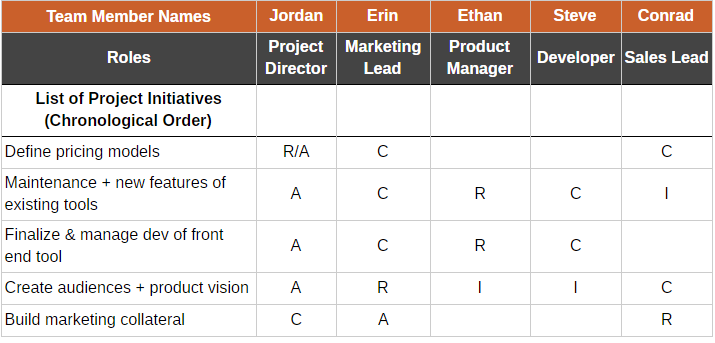What’s a RACI Matrix?
A few months ago, I took the lead on an internal project at Seer that had been humming along for about 12 months, and I reached out to Alisa for a gut check on how to approach wrapping my arms around the thing. It was a big project with about 15 stakeholders who were contributing to it on an ongoing basis, many of whom were working in silos.
She recommended that I build a RACI matrix in order to better understand who had done what historically and then use it as a framework to build out who should be doing what moving forward. I had never heard of a RACI matrix, so I did some Googling. I stumbled across this article, which does a fantastic job summing up the matrix.
Here’s how the article describes what a RACI matrix is:
The RACI model brings structure and clarity in describing the roles that stakeholders play within a project. The RACI matrix clarifies responsibilities and ensures that everything the project needs to be done has someone assigned to do it.
The four roles that stakeholders might play in any project include the following:
- Responsible: People or stakeholders who do the work. They must complete the task or objective or make the decision. Several people can be jointly Responsible.
- Accountable: Person or stakeholder who is the "owner" of the work. He or she must sign off or approve when the task, objective or decision is complete. This person must make sure that responsibilities are assigned in the matrix for all related activities. Success requires that there is only one person Accountable, which means that "the buck stops there."
- Consulted: People or stakeholders who need to give input before the work can be done and signed-off on. These people are "in the loop" and active participants.
- Informed: People or stakeholders who need to be kept "in the picture." They need updates on progress or decisions, but they do not need to be formally consulted, nor do they contribute directly to the task or decision.
As the article above states, the RACI matrix helps provide structure for various roles on a project. As Alisa suggested, putting this together was my first action item when taking over this new project - it helped me understand not only who had been contributing to the project, but also gave me a framework for breaking down silos so that we could organize one cohesive project plan as a singular unit, segmented by workstreams. I’ll get into more detail in the next section, but using this framework for team organization was a real eye-opener for me.
![]()
Why is this a valuable tool?
I’ve found that especially for marketing practitioners, the success of our work extends far beyond the reach of ourselves and our immediate teammates. For example, we might rely on a developer that’s not on our team to implement our recommendations, or we may rely on the consultation of a designer to help build the perfect new ad. The RACI matrix allows you to understand who should be responsible, accountable, consulted, and informed for each tactic or action item on a project. And I’ve found that the process of outlining that information is immensely valuable before you build a project plan.
![]()
How do I build a RACI Matrix?
Building a RACI matrix isn’t rocket science and should take no longer than 30 minutes. Here are the steps that I recommend:
1) Define Your Stakeholders
- Open an Excel sheet and list the names of each and every stakeholder on your immediate team on the first row
- On that same row, now list the names of everyone within 1 or 2 degrees of separation from your team. These are mainly folks that will not be responsible or accountable for the work directly, but that will be informed and/or consulted for the actions that your team takes. Like the developer or the designer from the example above
2) List the Actions That Your Team Will Take
- In the first column, list all of the actions that your team will take, i.e. your project initiatives. Do this in chronological order
3) Assign Roles To Each Team Member
- Next, for each action item, identify who should be responsible and accountable for each task, and who will be consulted and informed for each task
- Note that each task should have someone responsible for it, and probably no more than one person accountable for each task
- Not every item will need to have someone consulted and informed, and that’s ok!
4) Share It With Your Team
- Finally, you should share the RACI Matrix with your team, in order to ensure that everyone is on the same page and agrees with their role for each action item
Your Finalized RACI Matrix should look like this:

Wrapping Up
As one of my favorite thinkers, Ray Dalio, once said, “recognize that it doesn’t take a lot of time to design a good plan. A plan can be sketched out and refined in just hours, but the process is essential because it determines what you will have to do to be effective. Remember - designing precedes doing!”
For your next big project that includes a spider web of stakeholders, will you try designing a RACI matrix? Let us know in the comments below. And you can contact us to learn more about how we like to structure our marketing projects at Seer. We’d love to hear from you.
Sign up for our newsletter for more posts like this - delivered straight to your inbox!


